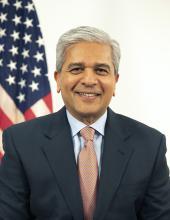
EIS at GSA ‘like a locomotive that you throw coal on’
The Enterprise Infrastructure Solutions Program (EIS) transition is underway at the General Services Administration. In fact, the acting deputy assistant commis...
The Enterprise Infrastructure Solutions Program (EIS) transition is underway at the General Services Administration. In fact, Allen Hill, GSA’s acting deputy assistant commissioner in the Federal Acquisition Service, said it’s “like a locomotive that you throw coal on and it gets faster.”
Over the past several months, vendors waited for solicitations to come out and for more awards to be made.
“We have 208 solicitations that are expected right now,” Hill told Federal News Network’s Jason Miller on Federal Monthly Insights – EIS. And nearly 22% of the plan task orders. “That’s 45 out of 208 Fair Opportunities, of which 29 have had task orders by large agencies, 14 of those by medium agencies, and two of them are small agencies.”
The Fair Opportunity solicitations are being put out to industry, and industry is responding.
“Agencies are being very deliberate in making their awards. So they’re taking the extra time,” Hill said on Federal Drive with Tom Temin, to make sure everything is in order, which might also be why there are fewer protests. “But also, the vendors are doing a great job in responding and providing the type of value that is needed for these agencies to make those decisions on what vendor gets selected for that award.”
There also seems to be a broader base of contractors and more competition in the market, leading some awards to go to so-called non-incumbents.
“Yes, there have been those, I would say, ‘disruptor companies’ that have come in under EIS that are making value propositions to agencies and giving them alternatives … to bring in those services that they’re offering,” Hill said.
Creating competition between vendors can result in innovative and better solutions.
“I think it’s great because that competition helps the other vendors sharpen their pencil a little more and be creative and everything in the how they offer services,” he added.
One benefit of the EIS program, is what some characterize as “steps” over the life of a 15-year contract, by adding new technologies as they emerge?
“We here at GSA are taking a different approach. We don’t want to get into the reactive mode of waiting for agencies to tell us what they need. We want to be proactive and working with the vendor community and offer those technologies out there. And so we’re constantly meeting with the vendors to find out what’s new out there to be able to offer,” Hill said.
He also feels the EIS transition brings with it experience and wisdom, by those who have seen previous transitions, like networks. He said it’s necessary to modernize their network and, when using cloud technology, to create a network that works with the cloud.
“So we’re trying to be the enablers for them, to not have to be concerned about what those technologies are and making sure that EIS is continuously able to deliver modernized capabilities for the agencies,” Hill said. “And that’s why it’s structured the way it is. It allows us to bring on those technologies so that agents can leverage them, unlike its predecessor, which is a little bit more legacy type approach. It’s the old school approach of doing telecommunications. EIS is more of the new way of how telecommunications should be done.”
Copyright © 2024 Federal News Network. All rights reserved. This website is not intended for users located within the European Economic Area.
Peter Musurlian is a producer at Federal News Network.
Follow @PMusurlianWFED
Related Stories





